
|
||
|
Portland art blog + news + exhibition reviews + galleries + contemporary northwest art
|
||
Rose McCormick's Grande Ronde at NAAU 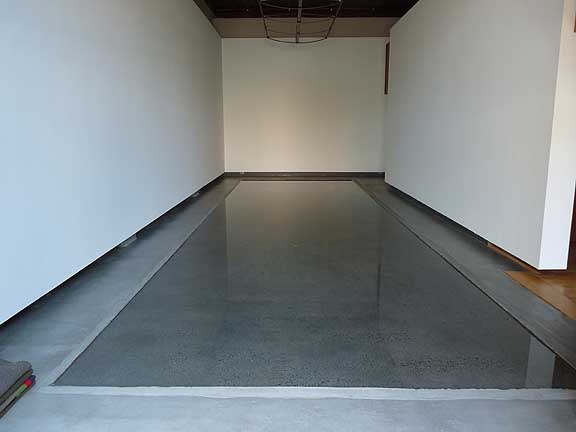 Rose McCormick's Grande Ronde Historically reflection pools have been the province of memorials like the Taj Mahal, Lincoln Memorial Reflecting Pool and the Oklahoma City Memorial, etc… all have a solemn shrine like aspect that encourages visitors to personalize and empathize amongst other more imposing and idiosyncratic edifices in their immediate environs. In a very real sense as well as philosophically, these pools bring far away objects into closer more temporally present view.  the Taj Mahal Like this exhibition, those structures are all inherently existential and imbued with a sense of history, but instead of civic level grandiosity Grande Ronde acts as kind of personal shrine to McCormick's own shifting and inherently subjective art practice. Notably, it invites viewers to explore, but equally wonderfully doesn't require them at all to operate as a piece. How the viewer comes to it or not is not the artist's concern and it's where this work seems more mature than some couture shows which tried too hard to manage or prompt viewers. 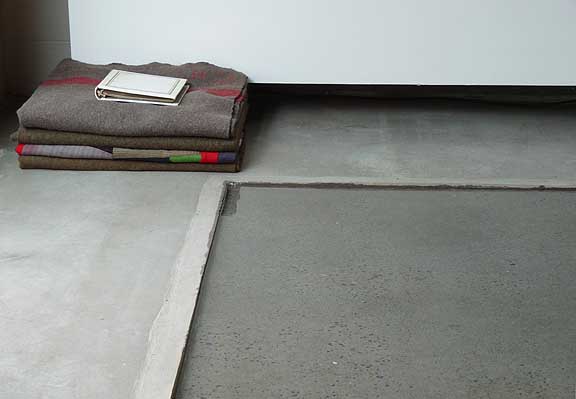 Blankets and scrap book That's partially why Rose McCormick's Grande Ronde marks a strong conclusion to NAAU's Couture series. By replacing her more specific canvases with a patiently insistent reflection pool it becomes a form of institutional critique (more of a comment here really) of the white gallery space she's shown and painted in as a studio. It also gives viewers a personal entry into McCormick's painting practice more fully than her painting performances as the painterly gray concrete overlay becomes the stretcher bar frame and the water the inexhaustible, inviolate and relentlessly existential tabula rasa… essentially a way to share that anxious painterly moment of beginning (or ending) without having to push imagery on the viewer. It is one of the great gifts of installation art and architecture to be able to act as environment rather than an object…. To provide context and not the focal point is liberating for both artist and viewer. 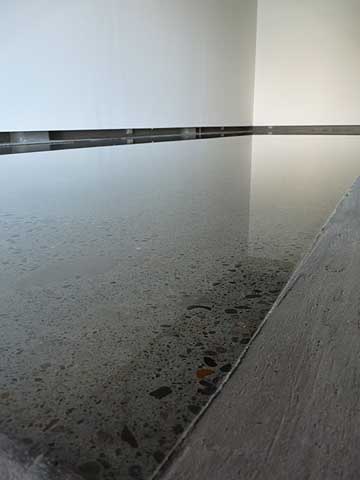
In fact, it's a complete and shocking departure for McCormick who up until now has been a talented, extremely curious but somewhat reticent painter of symbols, philosophically evidenced when her previous show presented herself as an installation of a painter painting… ultimately emphasizing the process over the finished painting as products. It isn't surprising that since that effort, she's been increasingly influenced by John Cage and Eric Satie's investigations into the process based intensification of time-based experiences, something which translates from music to subtle installation art quite well. As a conduit of temporal subjectivity Grande Ronde consists of a gallery sized reflecting pool, a tidy pile of blankets, a scrapbook, an antique fan, a video of the artist's statement and several old suitcases. The pool's surface, being subtly influenced by the fan, outdoor breezes and viewer's activity, creates an entirely existential feedback loop… one where the viewer is part of the system (but not necessary by any means). I call this the guest experience, where the viewer enjoys the hospitality of the space. 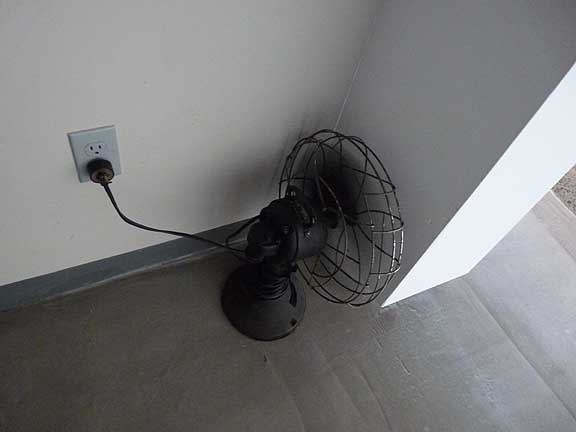 Grande Ronde's fan Similarly, the pool is easily navigated by viewers but the scrap book, blankets, suitcases and fan all create minor obstructions as differentiating reference points… like talking points at a meeting, the Stations of the Cross or stops along some interpretive nature trail. 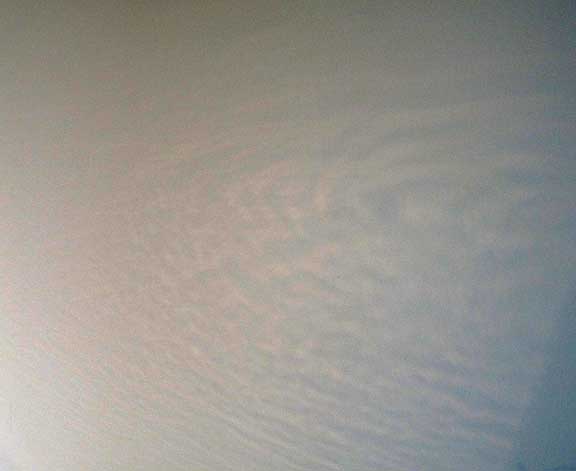 Grande Ronde's ripples of light on the walls I particularly liked how the fan activated wave reflections from the pool which are thrown across the far wall, where McCormick had previously installed herself some years before. This surface agitation prompted me to think of the act of art making as a way to create waves or ripples in the death like stillness that water will revert to without such stimulation. Thus, McCormick seems to have developed a way to produce action without performing as an artist, a major personal breakthrough that most artists can't "let go" enough to achieve. They have trouble letting go of the overinflated sense of self importance in the interpretation/understanding of the work... In any case, I don't sense any of that cling here and Rose seems to have stepped aside. 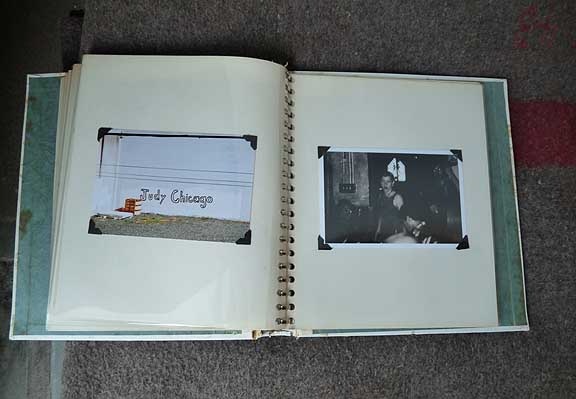
Still, McCormick's own scrapbook firmly inserts the artist's own artistic history into the viewers experience… making this more like visiting a specific monk's ascetic shrine (in this case McCormick's) than a more neutral art piece like Judd's Artillery sheds or a Robert Irwin piece. The suitcases, fan, blankets and even the painterly grey rim of the pool are all part of McCormick's signature aesthetics… whereas Judd and Irwin take pains to neutralize any signature. In fact the concrete edge of the pool bear an uncanny resemblance to her brushstrokes. Instead, McCormick's painterly reluctance (to be or not be a painter) has bourn a more complete repudiation of the idea of "finished work" as Grande Ronde is sort of invitation for temporal self examination as an experience. Instead of paintings or production of them, now the subject is the production of "contemplation", rather than a painter's typical finished "production" as subject of contemplation. Artists like Donald Judd and Robert Irwin have been down this road before but in many ways Grande Ronde has more to do with Beuys (the blankets), Richard Long (the path around the pool) and Walter de Maria (the elemental gallery filling pool) who all traffic in an almost shamanistic personal subjectivity as an environmental engagement. 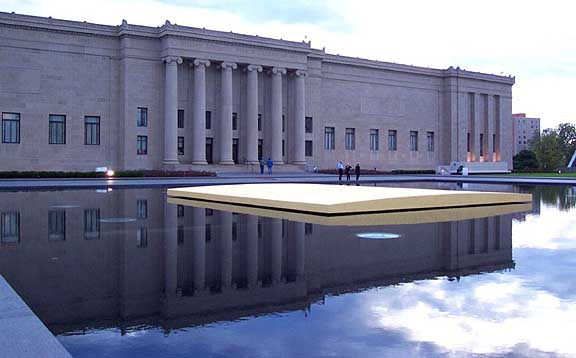 Walter De Maria's One Sun / 34 Moons at the Nelson-Akins Museum (lights in the pool are portholes to galleries) Overall, Its stripped down and room filling intensity most calls to mind, Walter De Maria whose work is less about objects than the siting of the contemplative viewer in a vast ordered field in one's immediate environment. Works like the Earth Room (similar with its elemental intervention), Broken Kilometer, the Lightning Field, Seen Unseen Known/Unknown and the Las Vegas Piece (in particular) are all about pilgrimage and physically negotiation of space, which then ultimately becomes an awareness of self in that environment. McCormick's blankets evem remind me of those at the lightning field, though hers are monogammed "RM". 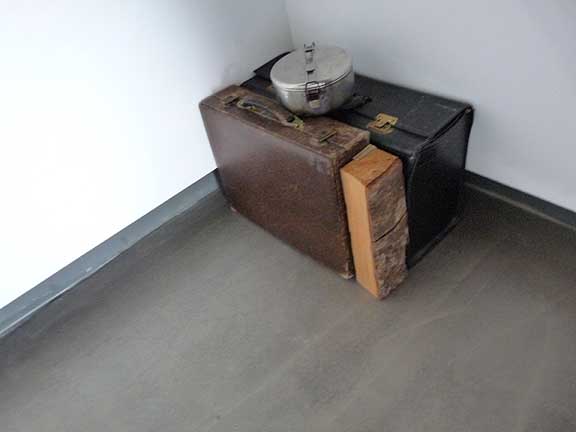 A pile of cool old stuff at Grande Ronde Are reflecting pools very original? No, but I don't think that's the point here, it's the luxury of taking the time to feel time washing over you and I suspect McCormick will have opportunities to pursue these ideas outdoors and in a more public space in the future. Her dealer is involved in real-estate development herself after all. After thumbing through the scrapbook atop the blankets, and walking the path I contemplated the space in a familiar, not new ways. NAAU is a space where I have spent a great deal of time and even shown myself… and every single time the large front window has been the focal point of activity. This time was no different, but the late August's summer day had its own particular charm and like John Cage's 4'33"… it isn't the silence, but the unintentional sounds and scenes that inhabit the void (that isn't a void) presented here. It's a rather successful piece and upon viewing Grande Ronde, I felt a deep sense of nostalgia for something that had passed only minutes ago… yet it was also part of a continuum… as if like every visit to the gallery had been part of a daily walk, impressive for something I've only known for a few days. Posted by Jeff Jahn on September 01, 2009 at 8:06 | Comments (0) Comments Post a comment Thanks for signing in, . Now you can comment. (sign out)
(If you haven't left a comment here before, you may need to be approved by
the site owner before your comment will appear. Until then, it won't appear
on the entry. Thanks for waiting.)
|
| s p o n s o r s |
 |
 |
 |
 |
 |
 |
 |
 |
 |
 |
 |
 |
 |
 |
 |
 |

|
Site Design: Jennifer Armbrust | • | Site Development: Philippe Blanc & Katherine Bovee | |

